March 2023
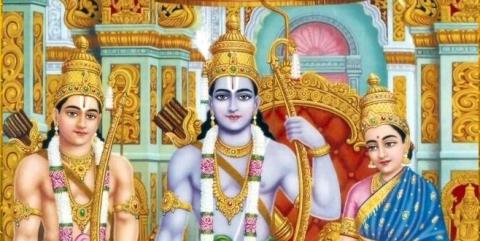
[Starting this Rāmanavami, every Friday, Prekshaa presents a condensed prose rendering of the Vālmīki-rāmāyaṇa based on the critically constituted text. We attempt to present the best aspects of the grand epic and also capture as many poetic details as possible. As envisioned by literary stalwarts like Prof. A R Krishnasastri and Dr. D V Gundappa, we hope this English rendering of the Rāmāyaṇa serves to be an easily accessible pen-picture of the...

Cindu – The word cindu means to jump or to leap; in the Telugu language, the word is also used in the sense of overflowing, springing up and pouring out. The dance form called cindu is described in Nṛtta-ratnāvalī and Saṅgīta-darpaṇa[1] (authored by Catura-dāmodara). The songs are set to dvipadi-chandas and are composed in the Telugu language. The composition contains an udgrāha (called ettugaḍè in Kannada) and a dhruva-pada (colloquially...
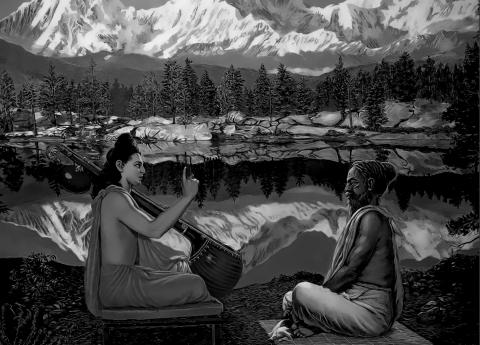
Introduction
dhyānābhyāsa-vaśīkṛtena manasā tannirguṇaṃ niṣkriyaṃ
jyotiḥ kiñcana yogino yadi paraṃ paśyanti paśyantu te ।
asmākaṃ tu tadeva locana-camatkārāya bhūyāc-ciraṃ
kālindī-pulinodare kimapi yan-nīlaṃ maho dhāvati ॥
dhyānāhbyāsadè tattvamaṃ hṛdayadoḻ tāṃ-ā nirākāramaṃ
kāṇalk-appoḍè kāṇge yogivarar-āṃ sāmānyar-èmmakṣig-ā ।
veṇu-svāna-sudhā-prasādi yamunā-kuñjodara-āmodi me-
ghānīla-dyuti nāṭyavāḍuge sadā nāṃ dhanyar-ā līleyiṃ...

88. Caurāparādhānmāṇḍavyanigraha-nyāya
Māṇḍavya was punished for the crime committed by the thieves. The story of Māṇḍavya comes in the Ādi-parva of Mahābhārata. Māṇḍavya maharṣi stayed in an āśrama in the forest, was immersed in tapas and was under a vow of silence. The soldiers were chasing thieves who were to be captured. The thieves dropped everything they had stolen in the āśrama and escaped. The soldiers thought that Māṇḍavya is the thief...
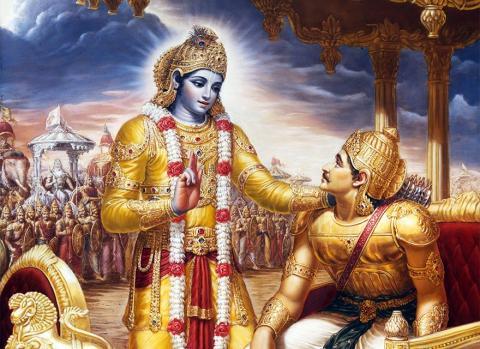
Śrī Kṛṣna was satisfied with this entreaty; Arjuna had been put on the path; his internal transformation was complete. Bhagavān felt certain that Arjuna was ready to perform the requisite deeds.
mā te vyathā mā ca vimūḍha-bhāvo
dṛṣṭvā rūpaṃ ghoram īdṛṃ mamedam |
vyapeta-bhīḥ prīta-manāḥ punas tvaṃ
tad eva me rūpam idaṃ prapaśya ||
BG 11.49
“Be free of worry and confusion. You were frightened because of the vision of my terrifying form...
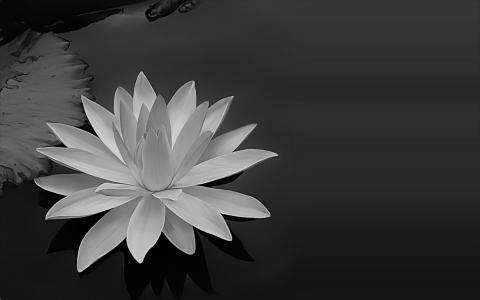
ಆದಿಪ್ರಾಸದ ನಿರ್ಬಂಧ ಇಲ್ಲವಾದ ಬಳಿಕ ಮತ್ತೆ ಕನ್ನಡಕ್ಕೆ ಶ್ಲೋಕ ಬರಬಹುದಿತ್ತು ಎಂಬ ಪ್ರಶ್ನೆ ಏಳಬಹುದು. ಇದಕ್ಕೂ ಕಾರಣವಿದೆ. ಆದಿಪ್ರಾಸ ಅಳಿಯುವ ಹೊತ್ತಿಗೆ ಹಳಗನ್ನಡವಿರಲಿ, ನಡುಗನ್ನಡವೂ ಅಳಿದು ಹೊಸಗನ್ನಡದ ಯುಗ ಮೊದಲಾಗಿತ್ತು. ನಾವು ಈ ಮೊದಲೇ ಕಂಡಂತೆ ಶ್ಲೋಕಕ್ಕೆ ಒಗ್ಗುವ ಭಾಷೆ ಹಳಗನ್ನಡವೇ. ಅಷ್ಟೇಕೆ, ಕಂದ-ವೃತ್ತಗಳಿಗೆಲ್ಲ ಇದೇ ಅನಿವಾರ್ಯ. ನಡುಗನ್ನಡ-ಹೊಸಗನ್ನಡಗಳಲ್ಲಿ ಈ ಎಲ್ಲ ಬಂಧಗಳು ನೀರಿಲ್ಲದ ಸರೋವರದ ಮೀನುಗಳಂತೆಯೇ ಸರಿ. ಹೀಗಾಗಿ ಶ್ಲೋಕದ ಪ್ರವೇಶಕ್ಕೆ ನವೋದಯವೂ ಒದಗಿಬರಲಿಲ್ಲ. ಮತ್ತೂ ಮುಂದಿನ ಕಾಲದಲ್ಲಿ ಛಂದಸ್ಸೇ ಬಹಿಷ್ಕೃತವಾದುದು ತಿಳಿದ...
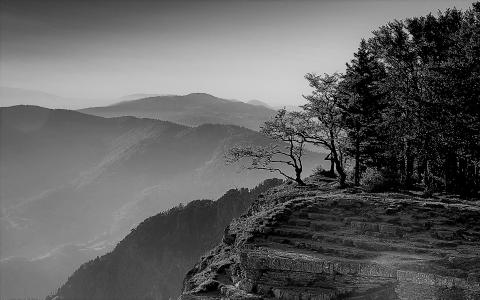
The daśa-rūpakas and many upa-rūpakas need to be staged using mārga-karaṇas, mārga-cārīs, and mārga-sthānakas; these have to come along with nṛtta-hastas as well; aṅgahāras may be employed as necessary. Thus, mastery over the grammar of the mārga-tradition is extremely important. Similarly, in the case of quite a few upa-rūpakas and forms of nṛtya documented in the treatises on saṅgīta-śāstra, mastery over the deśī grammar is important. Such...
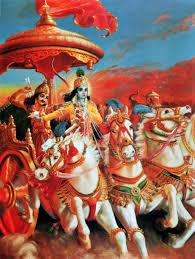
Here, by “divine eyes” we do not need to imagine a pair of extra-physical eyes with their own eyeballs and eyelids. It is enough to think that Bhagavān endowed the eye with the ability to behold divine effulgence. This is what we have to understand - when we pray to Īśvara for a boon, we need to ask for the requisite strength to bear and control the blessing. Our desires know no limits and make us forget what is suitable and what is not. If...

ಕರ್ಷಣಜಾತಿಗಳು ಮಾತ್ರಾಜಾತಿಗಳಂತೆಯೇ ಏಕದೇಶಸ್ಥಿರವಾಗಿವೆ. ಈ ಸ್ಥಿರತೆ ಪದ್ಯಬಂಧಗಳ ಚಾಕ್ಷುಷರೂಪದಲ್ಲಿರದೆ ಶ್ರಾವಣರೂಪದಲ್ಲಿ ಕಾಣಸಿಗುತ್ತದೆ. ಅಂದರೆ, ಕರ್ಷಣಜಾತಿಗಳ ಭಾಷಾಪದಗತಿ ಗದ್ಯಕ್ಕಿಂತ ಬಲುಮಟ್ಟಿಗೆ ಬೇರೆ ಎನಿಸದ ಹಾಗೆ ಅನಿಬದ್ಧವಾಗಿ ತೋರುತ್ತದೆ. ಅವುಗಳ ಪದ್ಯಗತಿ ಛಂದಃಪದಗತಿಯ ಮೂಲಕ ಮಾತ್ರ ಉನ್ಮೀಲಿಸಬೇಕು. ಆದುದರಿಂದಲೇ ಇವುಗಳ ಭಾಷಾಪದಗತಿ ಹೇಗೇ ಇದ್ದರೂ ಏಕ / ಆದಿ, ರೂಪಕ, ಖಂಡ ಮತ್ತು ಮಿಶ್ರ ಎಂಬ ನಾಲ್ಕು ಬಗೆಯ ಮೂಲಭೂತ ಲಯಗಳಿಗೆ ಒಗ್ಗುವಂತೆ ಪದ್ಯಗತಿ ಕರ್ಷಣದ ಮೂಲಕ ರೂಪುಗೊಳ್ಳುತ್ತದೆ. ಇದನ್ನು ಸಾಂಗತ್ಯದಂಥ ಒಂದು ಬಂಧ ಶ್ರಾವಣರೂಪದಲ್ಲಿ ನ...

79. Ghaṭīyantra-nyāya
For irrigating the fields in the villages there will be a contraption with a wheel fitted to the wells called ghatīyantra. Some of the cups attached bring up water, empty them on the ground and go down. This continues relentlessly. In the same manner the living beings go around the wheel of saṃsāra. Birth and death go on one after the other. Death after birth; birth after death. The cups come up to the ground holding water...
